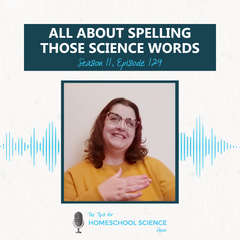FREE Shipping on all our products! (Please Note: Orders may experience a delay of a week or more in shipping due to the high volume of orders at this time of year.)
FREE Shipping on all our products! (Please Note: Orders may experience a delay of a week or more in shipping due to the high volume of orders at this time of year.)
Are you considering buying a microscope for your homeschool? {Episode 27}
May 08, 2017 2 min read
Are you considering buying a microscope for your homeschool? {Episode 27}
Looking through a microscope opens the doors to a normally invisible world for our students. Using one will help them to appreciate how complex life really is. However, choosing a microscope for homeschool use can be a bit daunting.
In this episode of the Tips for Homeschool Science Show, I’m sharing tips on how to choose a microscope for homeschool science!
Share the Tips
If you found these homeschool science tips to be helpful, would you please take a moment to rate it on iTunes or Google Play? This would help me tremendously in getting the word out so that more ear buds are filled with science-teaching encouragement.
The Highlights

What should you look for in a microscope?
When purchasing a microscope for homeschool use, look for the following specs:
- A compound monocular microscope;
- A microscope with 4x, 10x, and 40x objective lenses at a minimum (Note: The eyepiece should also give 10x magnification, which then will allow you to look at an object at 40x, 100x, and 400x magnification.);
- A microscope with separate coarse and fine adjustment knobs;
- A good light source. (Note: The best light sources are a LED or cool fluorescent bulb. Do not get one with mirror illumination as they are very difficult to adjust.)
Where can you buy a microscope?
What else should you get?
You absolutely must have some kind of dust cover for your microscope!
You can also purchase a soft or hard case for your microscope. If you plan on transporting your microscope, definitely look at buying a hard case.
Here is a list of several additional materials that will be helpful (but not necessary):
- Prepared slide set
- Blank slides with coverslips (for making your own slides)
- Concave slide (for viewing small, but thick samples)
- Lens paper (for cleaning the lens)
- Petri or sample dish (for samples that are too large for a slide)
- Test tube with stopper (for mixing samples)
- Non-toxic stain (for staining samples for easier viewing)
- Eyedropper (for making wet mount slides)
- Forceps (for collecting and manipulating samples)
Do you have any questions about selecting a microscope for homeschool use that I didn’t cover? Email them to podcast@elementalscience.com!
Need a bit more help with microscopic science? Check out the following:
Also in {Podcast} The Tips for Homeschool Science Show
All About Spelling Those Science Words {Season 11, Episode 129}
March 25, 2024 7 min read

In this episode, we'll be interviewing Robin Williams from All About Spelling. Click "Read More" to listen is as we discuss tips and tricks for spelling all those science words!
How should you handle notebooking through the different ages? {Season 11, Episode 128}
March 18, 2024 3 min read

Writing in Science with a Well-Trained Mind (Interview) {Season 11, Episode 127}
March 11, 2024 16 min read

Click "Read More" to listen in as Susan Wise Bauer and Susanna Jarret join Paige to share tips and tools about the third key to teaching science!
Subscribe
Sign up to get the latest on sales, new releases and more …

